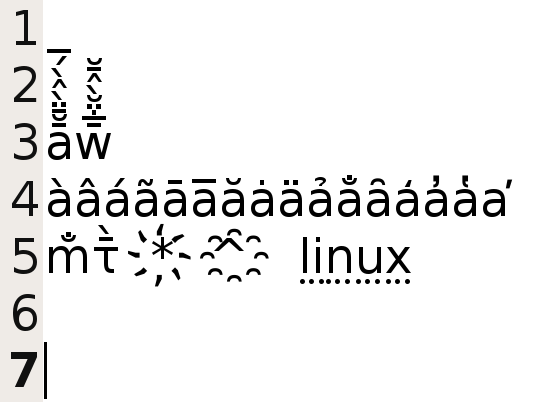Keyboard layout for combining diacritics
February 20, 2008
Typically, if you want to type characters with accents, such as á, ë, ś, you need to configure a suitable keyboard layout that includes compose sequences for those characters. The produced characters are what we call as precomposed characters; which were included in the early stages of Unicode. Nowdays, the idea is that you do not need to define á as a distinct character because it can be represented as a and ´, where the latter is a combining diacritic.
When put together a character and a combining diacritic, they fuse together, producing a seemingly single character. á is a precomposed (really one character), while á is letter a and the combining diacritic called acute (two characters). You can type the latter á by
- Type a
- Press Ctrl+Shift+u, then type 301, then press space bar.
Western languages do not really require combining marks, so the existing keyboard layouts do not use them. Other scripts, such as the Congolese keyboard layout (based on Latin) make good use of them.
This is gedit showing off pango and DejaVu fonts (default font in major distributions).
Line 3 is a bit of an extreme, showing a sandwich of combining diacritics.
Line 4 shows the base character a with the combining diacritics from the Unicode range 0x300 to 0x315.
Both lines 3 and 4 were produced easily with a modified keyboard layout, which is show below.
Line 5 is just me being silly. You can have combining diacritics that enclose your base character.
$ cat /usr/share/X11/xkb/symbols/combining
partial alphanumeric_keys alternate_group
xkb_symbols "combining" {
name[Group1] = "Combining diacritics";
key.type[Group1] = "FOUR_LEVEL";
key <AD11> { [ NoSymbol, NoSymbol, 0x1000300, 0x1000301 ] }; // à á
key <AD12> { [ NoSymbol, NoSymbol, 0x1000302, 0x1000303 ] }; // â ã
key <AC10> { [ NoSymbol, NoSymbol, 0x1000304, 0x1000305 ] }; // ā a̅
key <AC11> { [ NoSymbol, NoSymbol, 0x1000306, 0x1000307 ] }; // ă ȧ
key <BKSL> { [ NoSymbol, NoSymbol, 0x1000308, 0x1000309 ] }; // ä ả
key <AB08> { [ NoSymbol, NoSymbol, 0x1000310, 0x1000311 ] }; // a̐ ȃ
key <AB09> { [ NoSymbol, NoSymbol, 0x1000312, 0x1000313 ] }; // a̒ a̓
key <AB10> { [ NoSymbol, NoSymbol, 0x1000314, 0x1000315 ] }; // a̔ a̕
};
$ diff -u /usr/share/X11/xkb/symbols/us.ORIGINAL /usr/share/X11/xkb/symbols/us
--- /usr/share/X11/xkb/symbols/us.ORIGINAL 2008-02-20 11:11:13.000000000 +0000
+++ /usr/share/X11/xkb/symbols/us 2008-02-20 13:02:07.000000000 +0000
@@ -492,3 +492,12 @@
name[Group1]= "U.S. English - Macintosh";
};
+partial alphanumeric_keys modifier_keys
+xkb_symbols "combining_us" {
+
+ include "us"
+ include "combining"
+
+ key.type[Group1] = "FOUR_LEVEL";
+ name[Group1] = "U.S. English - Combining";
+};
$ diff -u /usr/share/X11/xkb/rules/xorg.xml.ORIGINAL /usr/share/X11/xkb/rules/xorg.xml
--- /usr/share/X11/xkb/rules/xorg.xml.ORIGINAL 2008-02-20 11:27:00.000000000 +0000
+++ /usr/share/X11/xkb/rules/xorg.xml 2008-02-20 11:27:48.000000000 +0000
@@ -3643,6 +3643,12 @@
<description xml:lang="zh_TW">Macintosh</description>
</configItem>
</variant>
+ <variant>
+ <configItem>
+ <name>combining_us</name>
+ <description>Combining</description>
+ </configItem>
+ </variant>
</variantList>
</layout>
<layout>
$ _
Then, you select this keyboard layout (U.S. English) and variant (Combining) in the Keyboard Indicator applet.
Unlike dead keys, with combining diacritics you first type the base character (such as a) and then any combining diacritics.
Our sample layout variant puts the diacritics in the physical keys for [];’#,./. For example,
- a + AltGr+[ : à
- a + AltGr+Shift+[ : á
- a + AltGr+[ + AltGr+’ : ằ
If your language has needs that can be solved with combining diacritics, this is how they are solved.
It is quite important to create keyboard layouts for all languages, and actually make good use of them.

February 21, 2008 at 9:57 pm
να ρωτήσω κάτι?
πριν καμια βδομάδα είχα κανει εγκατάσταση ttf windows για να βλέπω καλά του χαρακτήρες στο dreamweaver μεσo wine
ανακάλυψα χθες οτι δεν μπορώ να γράψω διαλυτικά στους ελληνικούς χαρακτήρες!!!
ενώ παλαιότερα μπορούσα με shift+ :
για παράδειγμα γά̓ιδαρος
υπάρχει κάποια λύση???
χρησιμοποιώ ubuntu 7.10 με gnome interface
February 21, 2008 at 10:38 pm
It works for me, when I use the “notepad” test application of wine: ΐ
Could you please check if that application is ok on your system?
February 22, 2008 at 10:42 am
το πρόβλημα με τα διαλυτικά δεν είναι μονο στο wine αλλά παντού, γενικα δεν μπορώ να γράψω διαλυτικά 🙁
February 22, 2008 at 1:17 pm
Run
gconftool-2 -R /desktop/gnome/peripherals/keyboard/kbd
and paste here the results.
February 22, 2008 at 10:49 pm
layouts = [us,gr polytonic]
model =
options = [grp grp:alt_shift_toggle]
overrideSettings = true
February 23, 2008 at 11:28 pm
lithike to provlima
ithele aplo kai oxi polytonic pou xrisimopiousa
anyway
thanks for your time
February 25, 2008 at 4:08 pm
For Greek Polytonic, you can get ano teleia by pressing Shift+[.